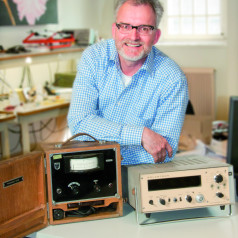Book review: ABC of Capacitors
Scope and size
‘Little’ is apt here because that companion, ABC of Capacitors by Stephan Menzel is small: just 76 pages as opposed to a whopping 308 for the Trilogy. But like the Trilogy of Inductors it’s a hard bound book, it’s cheap (€9.90 from the Elektor Store), and has the same crisp layout and high paper quality.Of course, Würth are big-gun suppliers of “almost-anything-capacitor” but to say that ABC of Capacitors is published to sing their own praises (i.e. sell-sell-sell) is missing the point – there isn’t a single Würth order number in the book. Instead of commercializing, Würth operate at the root: the knowledge level. In the tradition of Trilogy of Inductors, the new book ABC of Capacitors is a solid discussion of electrical, electronics- and physics related aspects of the component sec, in this case the capacitor. Audiophools will not find anything in the booklet to underpin with conviction the results of their “Sunday afternoon sound session with ultra-linear cap XYZ at just $45 each”. Rather, in the book they will read about non-subjective things like a capacitor’s tangens-delta factor, and hopefully draw their conclusions. All the while of course enjoying the music at very low distortion.
Order must be
As suggested by its subtitle the book follows this order in presenting the information:- Basic Principles
- Capacitor Characteristics
- Capacitor Types
The weak point of the booklet is not found in errors, omissions or long winded formulations — quite the opposite — but in the absence of a closing chapter on capacitor selection in practice. There is a hint of this minor shortcoming in chapter 3 already, which duly discusses these capacitor types with a fixed capacitance: film, electrolytic and ceramic, the latter divided in Class-1 through -4. Sadly the types are not linked to any typical applications in the industry, which would have made a smooth transition to a selection guide to close off the book. For example, although the NP0 capacitor is mentioned as belonging to the Class 1 ceramics with a temperature coefficient TC=0 (in theory), a short discussion of its use in oscillators would have helped to give the book a more practical look and feel. I do respect the clear perimeter though set out in this regard by the author: theory goes before practice.
Read full article
Hide full article

About Jan Buiting
Jan Buiting (1958) has been active in electronics and ways of expressing it since the age of 15. Attempts at educating Jan formally have so far yielded an F-class radio amateur license, an MA degree in English, a Tek Guru award, and various certificates in ele... >>



Discussion (3 comments)
JLM7174 7 years ago
TheEditor 7 years ago
jan
JLM7174 7 years ago
I didn't mean to "attack" you, but 4 monthes of absence were worrying us (you also pointed out that the move went smooth).
Hope to see you soon on Elektor,
JL